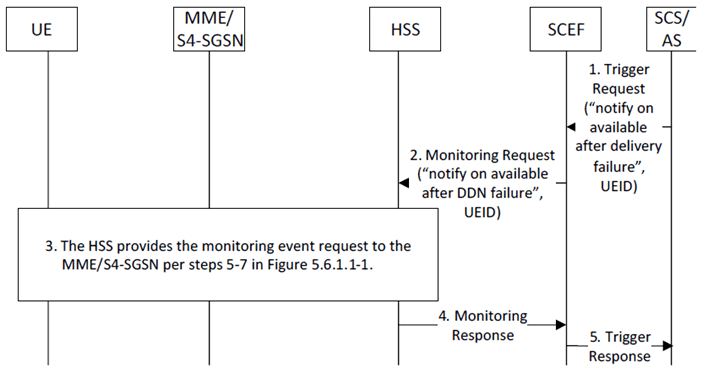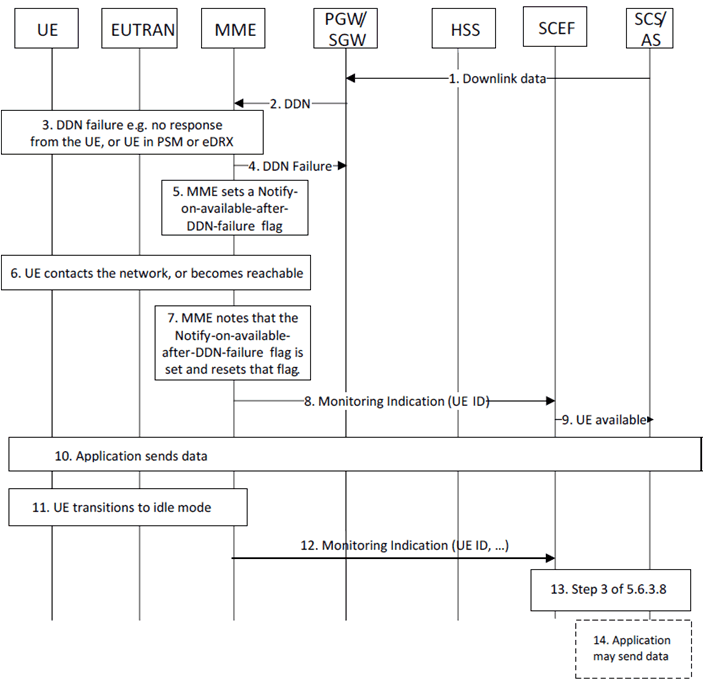Content for TS 23.682 Word version: 19.1.0
1…
4.2
4.3…
4.4…
4.5…
4.5.7…
4.5.14…
4.6…
5…
5.3…
5.5…
5.6…
5.6.2…
5.6.6…
5.7…
5.8…
5.9…
5.13…
5.14…
5.15
5.16
5.17…
5.18
5.19…
A…
C…
5.7 High latency communications procedures
5.7.1 Availability Notification after DDN Failure
5.7.2 Notification using Monitoring Event "UE Reachability"
...
...
5.7 High latency communications procedures |R13| p. 88
5.7.1 Availability Notification after DDN Failure p. 88
5.7.1.1 General p. 88
In this feature, the AS subscribes once and then gets notification only when there has been some data delivery failure followed by the UE becoming reachable.
This feature involves an entry in the subscription for a UE for "network application triggering when the UE is available after a DDN failure". This is a different monitoring event from the "UE is reachable" monitoring event. This information is provided to the serving node (MME/SGSN) at registration. The serving node notes this and sets a Notify-on-available-after-DDN-failure flag after a DDN failure. If the flag is set when the UE next contacts the network, the serving node notifies the SCEF that the UE is reachable, and will clear the flag.
An important use case for this feature is the application that wants to communicate with a UE that sleeps for a long time. If downlink packets from the application are not delivered, the application recognizes that the UE is not available by lack of response within a reasonable time from the UE, and then await notification from the network (i.e. from the MME/S4-SGSN via the SCEF) of UE reachability. This procedure does not apply to a Gn/Gp-SGSN.
5.7.1.2 Event Configuration p. 88
The Figure 5.7.1.2-1 below provides the Event configuration procedure.

Figure 5.7.1.2-1: Event Configuration - Availability Notification after DDN Failure
(⇒ copy of original 3GPP image)
(⇒ copy of original 3GPP image)
Step 1.
The SCS/AS executes step 1 of clause 5.6.1.9.
Step 2.
The SCEF sends a Monitoring Request message to the HSS to request notification when the UE becomes available after a DDN failure.
Step 3.
The HSS provides the monitoring event request to the MME/SGSN according to steps 5-7 in Figure 5.6.1.1-1.
Step 4.
The HSS internally notes the request, and sends Monitoring Response message to the SCEF.
Step 5.
The SCEF executes step 9 of clause 5.6.1.9.
5.7.1.3 Notification p. 89
The Figure 5.7.1.3-1 below provides the notification procedure. This Figure is relative to EUTRAN, but the equivalent Figure for UTRAN can be directly derived from this.

Figure 5.7.1.3-1: Notification - Availability Notification after DDN Failure
(⇒ copy of original 3GPP image)
(⇒ copy of original 3GPP image)
Step 1.
The application sends downlink data.
Step 2.
The PGW forwards the data to the SGW. The SGW sends a Downlink Data Notification (DDN) message to the MME requesting that UE be paged.
Step 3.
The UE is in Power Saving Mode or Extended idle mode DRX, or the MME initiates paging for the UE but receives no response.
Step 4.
The MME sends a DDN failure indication to the SGW.
Step 5.
The MME notes the subscription option for notification of availability after DDN failure for the UE, and sets a Notify-on-available-after-DDN-failure flag. Not every DDN failure triggers this event. This event may be triggered only when the UE is in PSM or Extended idle mode DRX.
Step 6.
At some later time, the UE contacts the network (e.g. to perform a TAU, or a service request), or the UE becomes or is about to become reachable for paging (e.g. an eDRX Paging Transmission Window is reached).
Step 7.
The MME notes that UE is available and that the Notify-on-available-after-DDN-failure flag for the UE is set.
Step 8.
The MME sends a Monitoring Indication to the SCEF that the UE is available, according to clause 5.6.3.1. The MME also resets the Notify-on-available-after-DDN-failure flag for the UE.
Step 9.
The SCEF notifies the application that the UE is available.
Step 10.
The application may decide to resend data it has for the UE.
Step 11.
UE transitions to idle mode according to TS 23.401, e.g. CM-IDLE with PSM or eDRX.
Step 12.
If Idle Status Indication was requested during Monitoring Event configuration, and the MME/SGSN supports Idle Status Indication, then MME executes step 2a of clause 5.6.3.8, and includes the time at which the UE transitioned into idle mode, its granted active time (if PSM is enabled), the periodic TAU/RAU timer granted to the UE by the MME, the eDRX cycle length (if extended idle mode DRX is enabled), and the Suggested number of downlink packets if a value was provided to the S-GW in the message.
Step 13.
The SCEF executes step 3 of clause 5.6.3.8, and includes additional parameters specified in step 12 above.
Step 14.
The application may send queued data toward the UE.
5.7.2 Notification using Monitoring Event "UE Reachability" p. 91
If an SCS/AS wants to send downlink packet(s), the SCS/AS can request a One-time "UE Reachability" monitoring event by sending Monitoring Request message indicating Reachability Type as "Reachability for Data". The SCS/AS may send the packet data when it receives a notification that the UE has changed to connected mode or the SCS/AS may send a device trigger when it receives a notification that the UE will become reachable for paging. If the SCS/AS optionally wants to fine-tune the delivery of the downlink data within the time-window when the UE is reachable, the SCS/AS can configure optional parameter 'Maximum Response Time' with proper value, and/or request Idle Status Indication (as detailed in clause 5.6.1.4).